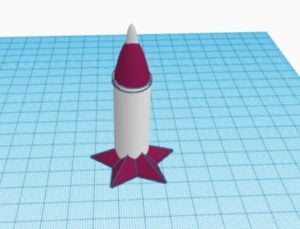Registrations are closed
In the future, to enable astronauts to stay on the Moon for long periods of time, new infrastructures must be developed to overcome important challenges. Such challenges include protection from radiation and meteorites, energy production, the extraction and recycling of water, food production and much more. The Moon Camp Challenge invites students to explore the Moon and decode some of the complexities future astronauts may face.
In Moon Camp Discovery each team’s mission is to 3D design only one component of a Moon Camp using Tinkercad. Teams can choose to design a:
– Lunar lander
– Moon Base
– Lunar rover
– Rocket
– Lunar Orbital Space Station
The design should be adapted to the Moon environment and if possible consider the use of local resources, provide protection and/or living and working facilities for the astronauts.
Moon Camp Discovery is a non-competitive mission for beginners. All teams that submit an entry that complies with the guidelines will receive a participation certificate and their project will be shared on the Moon Camp online platform.
Who can participate?
Participation is open worldwide to students aged up to 19 years old. Moon Camp Discovery is recommended for students aged 6 to 14 years old. Participating students must be supported by a teacher, educator or parent.
Discovery Projects Gallery 2020-2021
Below you can find some of the Moon Camp Discovery projects. For more projects visit the Moon Camp Discovery project gallery.
Team: ATENEA SALLE
Burgos Spain Category: Rocket
External link for Tinkercad 3D design
OUR ROCKET ATHENA.
Preschool Education, 4 years old.
Athena, goddess of wisdom and Science, gives our rocket its name. We have chosen this name because it is necessary to use all Science and the human wisdom known over centuries to build a rocket that can travel to our satellite: THE MOON
We had several assemblies all together to decide the shape and size of our rocket. As you can see it is quite long, like a rectangle standing up. It has a rocket tip at the end to travel very fast to the far away moon.
We had to include many things inside the rocket: beds, toilet, wardrobes, etc. We thought about a cylindrical round and empty rocket with enough space for the astronauts, because they need to move inside. Our rocket also needed a special deposit for fuel and another one to control everything and let the astronauts to pilot it. Finally, it was necessary to look for a base to hold the rocket before taking off.
We had the rocket design! Our teacher did it taking into account the students opinions and she was drawing every little part of the rocket on the interactive whiteboard.
Then, we were ready for the next step. Now, we had to talk about the materials to build the rocket. We thought about light materials to spend less fuel and let it to fly faster. We thought about resistant materials in hot or cold places (the heat of the blast from takeoff, lower temperatures into the space, etc)
It was a great project to build a space rocket. We have learnt many scientific concepts and we have enjoyed a lot!
Our final task was to decide the correct name for the rocket: ATHENA
















